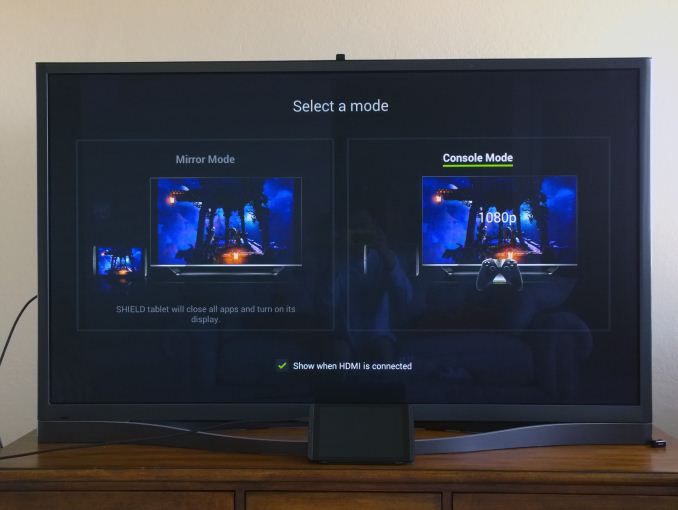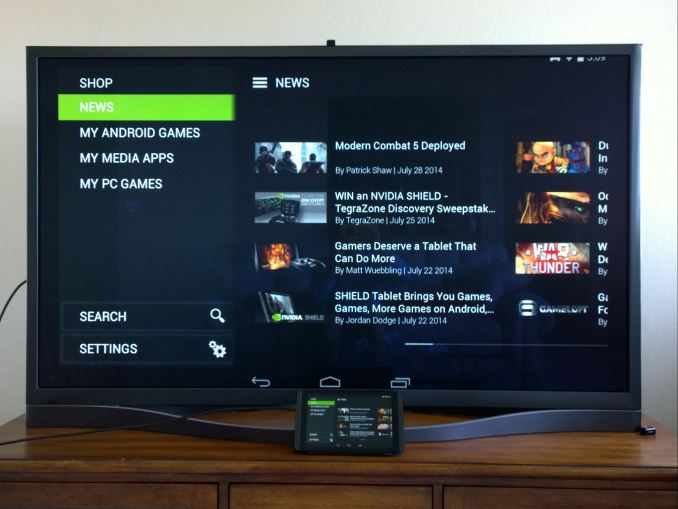The NVIDIA SHIELD Tablet Review
by Joshua Ho on July 29, 2014 9:00 AM ESTSoftware
In the UI department, there’s not too much to talk about. Much like Motorola, NVIDIA has stuck to using the AOSP UI design. Of course, there are plenty of NVIDIA-specific applications, but I didn’t run into any issues using the tablet to do everyday tasks. In this respect, things have improved massively over Shield portable. Because this tablet works in both portrait and landscape, there aren’t any issues with applications that force portrait mode like there were with the Shield portable. In normal tablet usage, it works as one might expect, with no real perceived lag throughout the UI. Of course, this is when compared to other Android devices. There are still frame drops involved in scrolling through lists and similar areas where Android has traditionally struggled to stay smooth, but Android L should fix this issue for the most part.
DirectStylus 2
The real value that the Shield tablet brings as a tablet is the stylus functionality. DirectStylus 2 is definitely much, much better than any other capacitive stylus on the market. The tip allows for precise control and it’s definitely responsive to changes in pressure. For the most part, there are only small issues here. Because the stylus is capacitive, it’s not really possible to have a floating pointer the way Wacom styluses do. In addition, I noticed that I need to lift the stylus a bit more than I might with pencil and paper in order to start a new letter or word or else my words would start to flow together. For the most part though, it works well enough, and the inking latency is low. Unfortunately the issue here is more of ecosystem than hardware, as most stylus-enabled applications aren’t nearly as robust as OneNote on Windows x86.
Console Mode
Of course, the real question here is whether the gaming side is worth the price premium. NVIDIA has gone all out on this area, and their efforts are split up into multiple aspects. The first is the TV interface/console mode, then the gameplay recording feature known as ShadowPlay. Finally, there’s the aspect of GameStream and GRID, which make it possible for games to be played on the tablet that otherwise wouldn’t work due to the compute requirements.
The TV interface effectively boils down to Shield Hub and Google Now, although it’s fully possible to use the full tablet UI as desired in this mode. In the hub, launching games and various applications like YouTube and Netflix is rather simple compared to the more cumbersome full Android UI as they have their own category in Shield Hub. In addition, launching applications through Google Now works as expected. Overall, there aren’t any friction points here. It works as well as one could expect. There is a strong reliance on voice input in general, but it’s much better than trying to type with a controller and better than most smart TV experiences. While the TV interface is mostly targeted towards enabling a console gaming experience, YouTube and Netflix both work great in this mode. NVIDIA has also gone through the necessary DRM certification process to allow for 1080p Netflix streaming. In essence, this device is already ready to serve as an Android TV device.
ShadowPlay
ShadowPlay, which we first saw in GeForce GTX GPUs, is also another major advantage that NVIDIA brings to the table for software experience. In short, this leverages the hardware H.264 video encoder that is on the Tegra K1’s Kepler GPU to provide video capture of gameplay or anything else displayed by the tablet. There are three possible options for video capture. The first is Twitch broadcasting, something that NVIDIA is quite proud of as they are the first to implement such a feature in an Android tablet. While I personally don’t stream on Twitch, a demo of Twitch broadcasting in the initial launch briefing worked without any visible quality issues in either audio or video.
There are two other recording modes. One is a standard start/stop recording feature, but the other is ShadowPlay/Auto Recording. In short, this keeps anywhere from the past minute to 20 minutes in video. This makes it possible to set and forget about the recording feature rather than constantly managing recordings in manual mode. All of these modes can use the tablet’s microphone and front facing camera for commentary purposes as needed. Local recordings seem to have a maximum of 1080p30, and Twitch broadcasts are limited to 720p30.
While those are the technical details, it’s a painless process. All the user has to do is long press the back button on the controller and select what kind of a recording they’d like to do (Twitch, Auto, Manual, Screenshot) and that’s it. I can see significant potential in this area especially if this device takes off as a gaming platform.
















174 Comments
View All Comments
kron123456789 - Thursday, July 31, 2014 - link
Yes, you can use your Xbox360 controller with that tablet.LedHed - Wednesday, July 30, 2014 - link
When is NVIDIA going to start putting competitive SSD's inside of their mobile devices?baii9 - Wednesday, July 30, 2014 - link
Any comparison with a bay trail win8.1 tablet?nicolapeluchetti - Thursday, July 31, 2014 - link
Am i the only one who doesn't see the point of a gaming tablet with only 2.5 hours of battery when playing games?The need of a tablet for gaming is more related to situations where you have to play for lots of time without charging. I know that you can dial down the graphics and save the battery, but then where are the difference from an iPAd Air (which also has many more games?). This is totally pointless for me, it could have been good if battery lasted 5-6 hours, like it is know it's pointless.hahmed330 - Thursday, July 31, 2014 - link
If you run an ipad air full blast the batteries will last for 2.5 hours only... This is what they did.. If you run say dead trigger 2 or something like that the battery would last per say 4-5 hours.. That's pretty damn impressive by the way... I really hope this is successful as I would love play some really nice games..semi177 - Friday, August 1, 2014 - link
the comments on this site used to be good to read. now i just see bashing and misinformed comments. The admin should consider pushing down fanboy war threads much lower down and keep the useful ones on top.TheinsanegamerN - Monday, August 4, 2014 - link
Anybody know where the 32GB tablet is, or when it will release? not even nvidia shows it as available on their website, nor even mentions it.scbundy - Thursday, August 7, 2014 - link
So much for Charlie D's prediction that the Tegra K1 was going to be super hot, have a huge heatsink and use 50W.Azurael - Friday, August 8, 2014 - link
It's a bit of a disappointment in the display department, much like the Tegra Note 7 (which uses exactly the same display as the original Nexus 7 with a marginally better calibration as far as I can see) The stylus is great (in fact, I prefer it to the Wacom-developed screen in the Galaxy Notes) as is the SoC performance and value proposition - but if they want to appeal to people other than gamers (I would certainly have bought this), they've got to work on that LCD. I skipped the Nexus 5 and bought a G2 despite objecting to its size because the N5 LCD was a massive step backward in contrast from that in the Nexus 4 when calibrated. I bought a 2013 Nexus 7 to replace my 2012 Nexus 7 a few weeks ago because the LCD in the otherwise great Tegra Note is not a step forward. When will device manufacturers other than Apple realise that people do care about the LCD?sandy105 - Tuesday, April 28, 2015 - link
I have both the tegra note 7 and nexus 7 2012 .The one on nexus 7 has bonded fused display while the touch layer and screen are separated on tegra note7 making it very poor and VERY reflective.It also has muted colors and looks washed out.